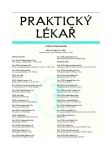Religion – evolution and neurobiology
Authors:
F. Koukolík
Authors‘ workplace:
Primář: MUDr. František Koukolík, DrSc.
; Národní referenční laboratoř prionových chorob
; Fakultní Thomayerova nemocnice s poliklinikou, Praha
; Oddělení patologie a molekulární medicíny
Published in:
Prakt. Lék. 2009; 89(11): 621-626
Category:
Various Specialization
Overview
The discourse on evolution and the nature of religion is similar to discourse on evolution and nature of language and music. The first theory explaining religion as a by-product of evolution supposes that at the core of a religion is a contra-intuitive belief in supernatural agents arising from innate „intuitions“, related to agency. Three cognitive constituents can be recognised in religions: religious and other supernatural representations are contra-intuitive, religion helps with anxiety (but can also provoke anxiety) and a part of religion is behaviour that deviates from maximalization of benefit. The second theory, which perceives religion as an adaptation, does not dispute the aforementioned arguments but alleges that a basic benefit of religion is the reinforcement of intragroup solidarity and thereby fitness of a member of the group. Contra-intuitive belief does not need to be necessarily maladaptive. Contemporary functional methods make it possible to observe neural correlates of religious belief and mystical experiences.
Key words:
religion, cognitive science, evolution, neural correlates of religious belief.
Sources
1. Alcorta, C.S., Sosis, R. Ritual, emotion and sacred symbols: the evolution of religion as an adaptive complex. Human Nature 2005, 16, p. 323–359.
2. Alcorta, C.S., Sosis, R. Why ritual works: a rejection of by-product hypothesis. Behavioral and Brain Sciences 2006, 29, p. 613–614.
3. Atran, S. In Gods we trust. The evolutionary landscape of religion. New York: Oxford University Press 2002.
4. Beauregard, M., Paquette, V. Neural correlates of mystical experience in Carmelite nuns. Neurosci. Lett. 2006, 405, p. 186–190.
5. Beauregard, M., Paquette, V. EEG aktivity in Carmelite nuns during mystical experience. Neurosci. Lett. 2008, 444, p. 1–4.
6. Boyer, P. Naturalness of religious ideas: a cognitive theory of religion. Berkeley: University of California Press 1994.
7. Boyer, P. Functional origins of religious concepts: conceptual and strategic selection of evolved minds. J.R. Anthropol. Inst. 2000, 6, p. 195–214.
8. Boyer, P., Ramble, Ch. Cognitive template for religious concepts: cross-cultural evidence for recall of counter-intuitive representations. Cognitive Science 2001, 25, p. 535–564.
9. Boyer, P. Religion explained. The evolutionary origins of religious thought. New York: Basic Books 2001.
10. Boyer, P. Religious thought and behaviour as by-products of brain function. Trends Cogn. Neurosci. 2003, 7, p. 119–124.
11. Collins, F.S. The language of God: a scientist presents evidence for belief. New York. Free Press, 2007.
12. Griffith, R.R., Richards, W.A., Cann, U. et al. Psylocybin can occasion mystical type experience having substatial and sustained personal meaning and spiritual significance. Psychopharmacology (Berl.) 2006, 187, p. 268–283.
13. Harris, E., McNamara, P. Is religousness a biocultural adaptation? In: Bulbulia J, Sosis R, Harris E, et al. The evolution of religion: Studies, Theories, and Critiques. Santa Margarita, CA: Collins Foundation Press 2008, p. 79–85
14. Harris, S., Kaplan, J.T., Curiel, A. et al. The Neural Correlates of Religious and Nonreligious Belief. PLoS ONE 2009; 4(10): e0007272. doi:10.1371/journal.pone.0007272
15. Kapogiannis, D., Barbey, A.K., Su, M. et al. Neuroanatomical Variability of Religiosity. PLoS ONE 2009A; 4(9): e7180. doi:10.1371/ journal.pone.0007180
16. Kapogiannis, D., Aron, K., Barbeya, M. et al. Cognitive and neural foundations of religious belief. Proc. Natl. Acad. Sci. USA 2009B,106, p. 4876 až 4881.
17. Kirkpatrick, L.A. Evolutionary psychology: An emerging new foundation for the psychology of religion. In R. F. Paloutzian & C. L. Park (Eds.), Handbook of the psychology of religion and spirituality. New York: Guilford, 2005
18. Koukolík, F. Sociální mozek. Praha: Karolinum 2006.
19. Koukolík, F. Před úsvitem, po ránu. Eseje o dětech a rodičích. Praha: Karolinum 2008.
20. Koukolík, F. Lidství. Neurobiologické podklady. Galén, Praha, 2010 (v tisku)
21. Linden, D.J. The accidental mind: how brain evolution has given us love, memory, dreams, and God. Cambridge, MA: Belknap Press 2007.
22. McClenon, J. Wondrous healing: shamanism, human evolution, and the origin of religion. DeKalb IL: Norther Illionis University Press 2002.
23. Previc, F.H. The role of extrapersonal brain systems in religious activity. Conscious. Cogn. 2006, 15, p. 500–539.
24. Ramachandran, V.S., Hirstein, W.S., Armel, K.C. et al. Neural basis of religious experience. Society for Neuroscience Conference Abstracts 1997, p. 1316.
25. Trimble, M.R. The soul in the brain: the cerebral basis of language, art and belief. Baltimore: Johns Hopkins University Press 2007.
26. Webster’s Unabridged Dictionary. 2nd ed. New York: Random House 1999.
27 Winkelman. M.J. Shamanism: The neural ecology of consciousness and healing. Wesport CT: Bergin and Garvey 2000.
Labels
General practitioner for children and adolescents General practitioner for adultsArticle was published in
General Practitioner

2009 Issue 11
Most read in this issue
- Nicotinism and the female skeleton
- Assessment of health state and working capacity of people suffering with locomotive system diseases
- Impaired function of muscles in the lower extremities in chronic obstructive pulmonary disease (COPD)
- Religion – evolution and neurobiology
